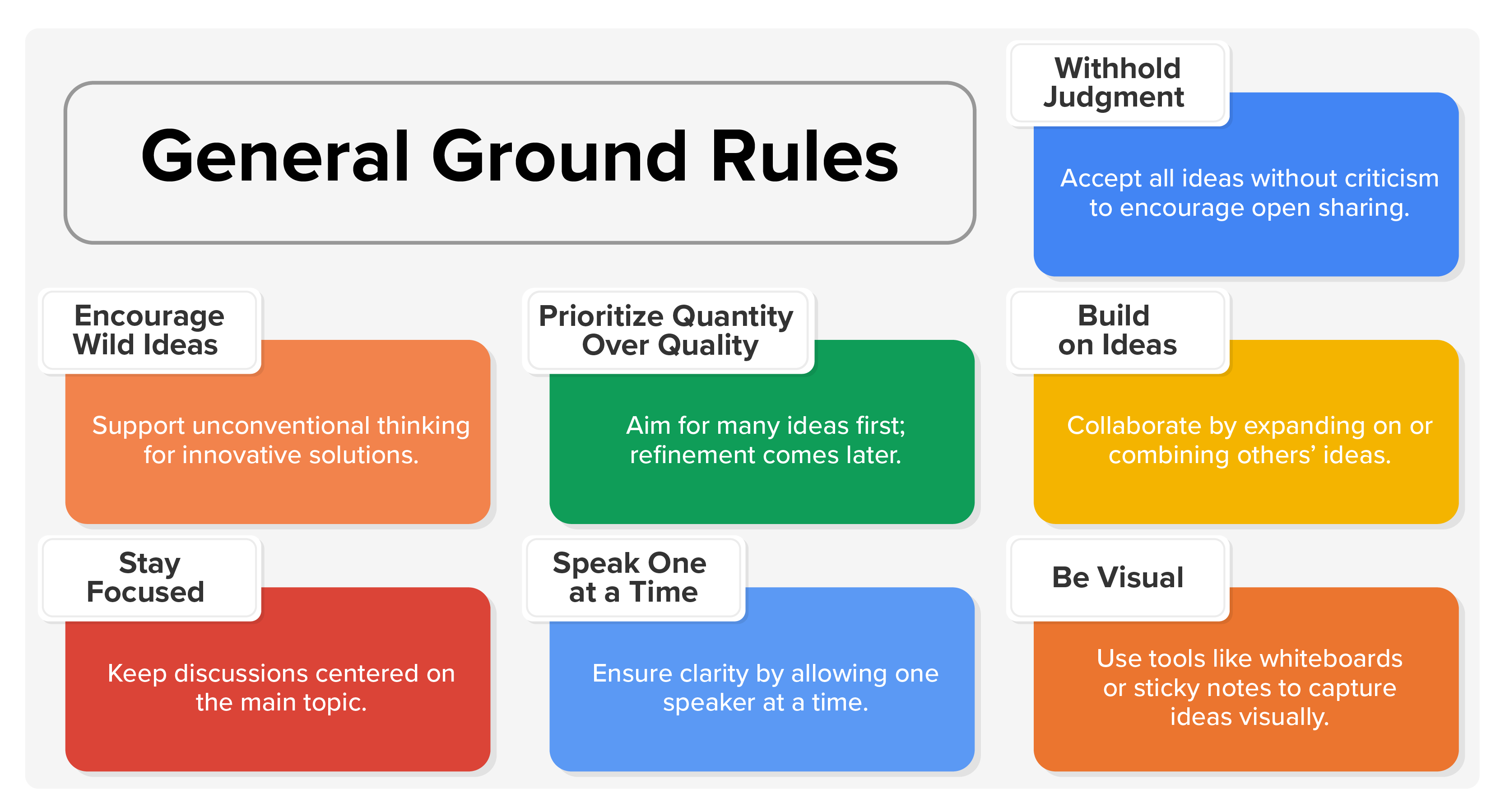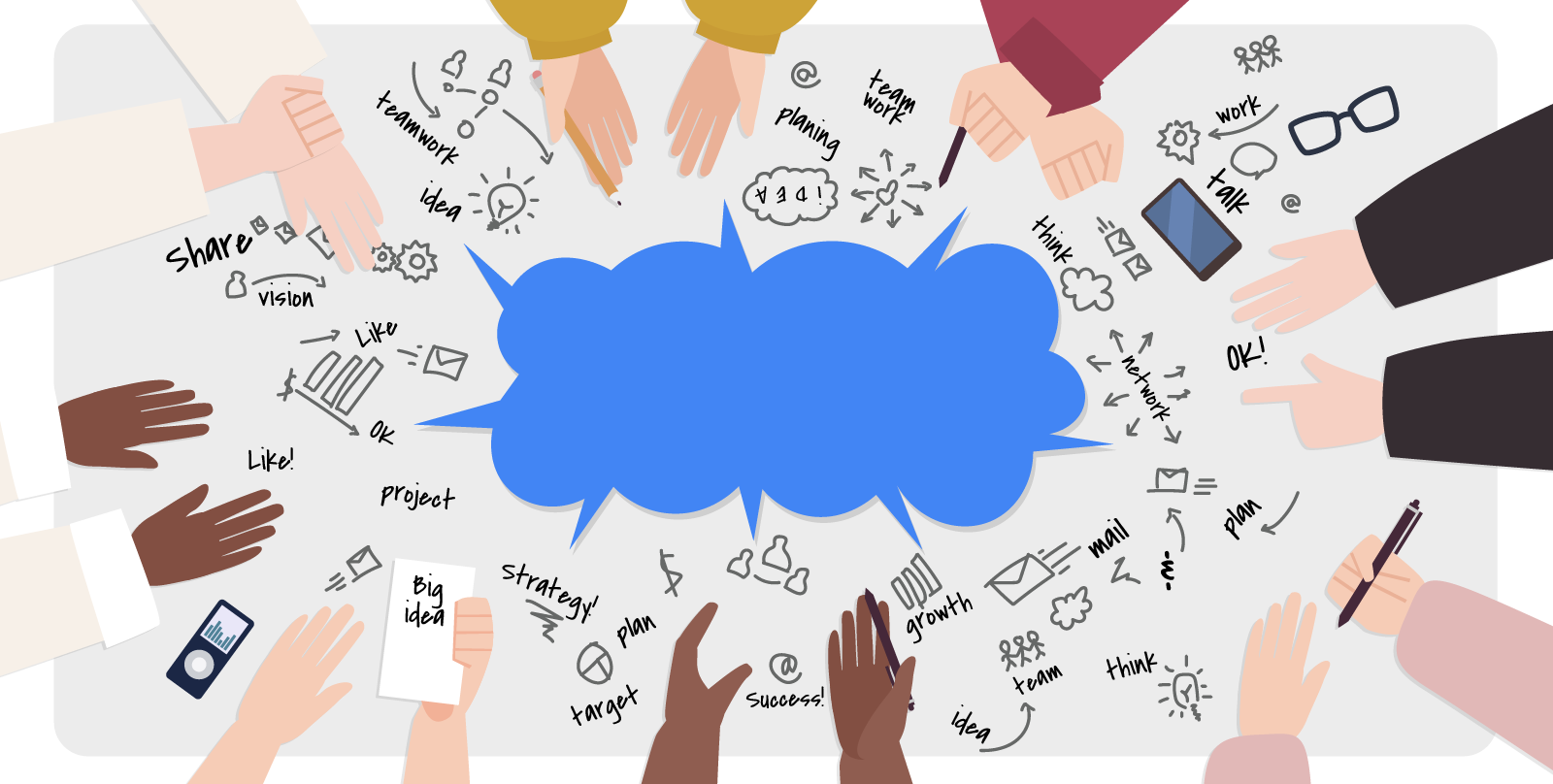Table of Contents |
Brainstorming is an effective tool for generating creative solutions in conflict situations because it promotes open dialogue and diverse thinking. Allowing all parties to share ideas without immediate judgment fosters collaboration and helps break down barriers. Diverse perspectives are especially valuable in conflict resolution, as they lead to more comprehensive solutions.
While brainstorming has been discussed before, dedicating a full lesson to it deepens understanding and practice. Exploring different methods and tools enhances our ability to guide productive sessions, leading to more effective, mutually agreeable outcomes.
In previous lessons, we’ve emphasized the need to separate people from problems in conflict management. Blaming statements attack a person’s character, leading to defensiveness and escalating the conflict, making resolution more difficult. Using I-statements shifts the focus to specific actions and their impact, promoting constructive dialogue. For example, instead of saying, “You’re irresponsible,” an I-statement would be “When you turn in the numbers late, I feel anxious because I need them to finish my report.” This approach addresses the behavior without attacking the person. Reminding parties of this during brainstorming can help set a productive tone.
In high-tension situations, establishing ground rules fosters a safe environment, encourages participants to contribute, and leads to more effective problem-solving.
Here are some general ground rules for brainstorming you can adapt to fit your own needs:

Brainstorming is a versatile tool in conflict resolution, allowing individuals or groups to generate a wide range of ideas to address issues creatively. While there are many approaches to brainstorming, each with its unique strengths, the key is to facilitate open and collaborative idea generation. Here, we explore several effective brainstorming techniques we haven’t yet covered in depth, providing examples of how they can be applied in conflict situations.
Traditional brainstorming is the most straightforward approach, where individuals or groups come together to generate as many ideas as possible related to the conflict without any critique or evaluation. The emphasis is on quantity over quality at this stage, encouraging participants to think freely and share even the most unconventional ideas.
EXAMPLE
In a workplace conflict where two departments are struggling with resource allocation, a traditional brainstorming session might involve team members listing all possible solutions, from reallocating the budget to implementing cross-training programs. The key here is that no idea is dismissed or criticized.Mind mapping is a visual brainstorming technique that helps organize ideas around a central conflict. This method involves creating a diagram where the main issue is placed at the center, and related ideas branch out from it. This technique makes it easier to see connections between different concepts and identify potential solutions.
EXAMPLE
In a family dispute about holiday plans, a mind map could start with “Holiday Planning” at the center. Branches might include different aspects like “Destination,” “Budget,” “Activities,” and “Dates.” Further branches can explore various options within each category, helping the family visualize possible compromises and solutions.The SCAMPER method was developed by Bob Eberle, an educational consultant and author, in the 1970s. It originated as a tool to help students enhance their creativity and problem-solving skills by encouraging them to think about existing ideas or products in new ways. SCAMPER is an acronym that stands for “substitute, combine, adapt, modify, put to another use, eliminate, and reverse.” Each prompt serves as a guide for generating innovative ideas by asking questions related to these different actions. Eberle built on earlier work by Alex Osborn, a pioneer in the field of creative thinking and brainstorming, and SCAMPER became widely adopted as a simple yet effective method for sparking creativity in various fields, from education to business. Even though it is an older tool, it is still helpful today.
EXAMPLE
In a project management conflict where team members disagree on the workflow, SCAMPER can be used as follows:Reverse brainstorming flips the traditional approach by asking, “How could we cause the problem?” instead of “How can we solve the problem?” This method can uncover underlying issues and stimulate creative thinking about potential solutions.
EXAMPLE
In a conflict between neighbors over noise complaints, reverse brainstorming could involve asking, “What actions could make the noise issue worse?” Answers might include hosting more loud parties or playing music late at night. By identifying actions that could exacerbate the problem, the group can better understand the root causes and brainstorm effective solutions, such as soundproofing or setting quiet hours.By applying various brainstorming techniques, groups can explore a broad spectrum of ideas, gain new perspectives on conflicts, and develop more innovative and comprehensive solutions. Whether one uses a mind map to visualize connections or SCAMPER to think outside the box, these methods help tap into collective creativity, making the problem-solving process more dynamic and effective.

Digital and physical tools can greatly enhance brainstorming, whether for remote or in-person teams. Digital tools like Miro, Mural, and Stormboard enable real-time virtual collaboration, allowing participants to share ideas, comments, and mind maps. These tools are particularly helpful for remote teams working across time zones, offering free limited plans and allowing asynchronous contributions. Google Suite and online meeting platforms also offer basic brainstorming features.
For in-person sessions, physical tools such as whiteboards, sticky notes, and flip charts help organize thoughts visually. Sticky notes can be used for brainstorming, where ideas are written down and later grouped for clarity. These tools can make the process more dynamic and interactive, helping participants visualize solutions more effectively.
Anonymous input tools like Poll Everywhere or digital suggestion boxes allow participants to provide honest feedback without fear of judgment, which is particularly useful in sensitive conflicts where open discussion may be inhibited by power dynamics.
These tools, when used correctly, make brainstorming more inclusive, organized, and effective, regardless of the setting.
A successful brainstorming session requires careful planning, starting with selecting a neutral facilitator to guide discussions impartially and choosing an environment that encourages open participation. Preparing participants with a clear agenda and the necessary tools ensures a structured and creative session. During facilitation, it’s important to keep discussions on track, encourage input from everyone, and maintain a judgment-free zone to foster the free expression of ideas. Once ideas are generated, evaluate them using criteria like feasibility and impact, group similar concepts to streamline decision-making, and prioritize the most promising solutions for implementation. This organized approach helps move from idea generation to actionable outcomes effectively. Read on to learn more!

A successful brainstorming session requires careful planning and consideration of several key factors. From selecting a neutral facilitator to choosing the right environment and preparing participants, each step plays a vital role in creating an effective and productive session.
By guiding the brainstorming process effectively and using structured evaluation techniques, you can help groups move from idea generation to actionable solutions that address conflicts meaningfully.
Avoiding groupthink is key to a productive brainstorming session, as it ensures diverse ideas are considered. Encourage a range of viewpoints by inviting input from those with different perspectives. Designating a “devil’s advocate” can challenge assumptions and stimulate critical thinking. It’s important to ensure quieter participants contribute by directly asking for their opinions.
Managing dominant participants is also essential. Round-robin techniques, where each person shares their ideas in turn, can help balance contributions. In virtual settings, tools like anonymous polling or digital whiteboards allow everyone to contribute equally.
To handle idea overload, categorize similar ideas into groups to identify common themes. Using a decision matrix to evaluate ideas based on feasibility, impact, and alignment with goals helps narrow down options to the most promising solutions, leading to actionable outcomes.
Source: THIS TUTORIAL WAS AUTHORED BY MARLENE JOHNSON (2019) and STEPHANIE MENEFEE and TRACI CULL (2024). PLEASE SEE OUR TERMS OF USE.
REFERENCES
De Bono, E. (1985). Six thinking hats. Penguin Books.